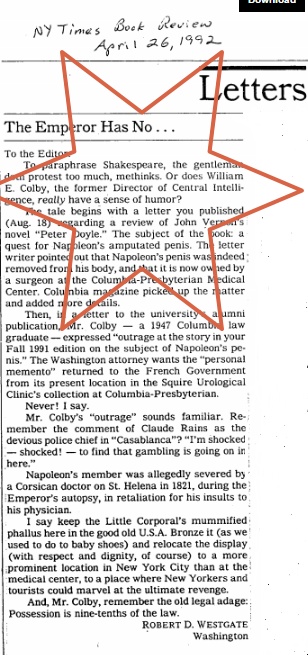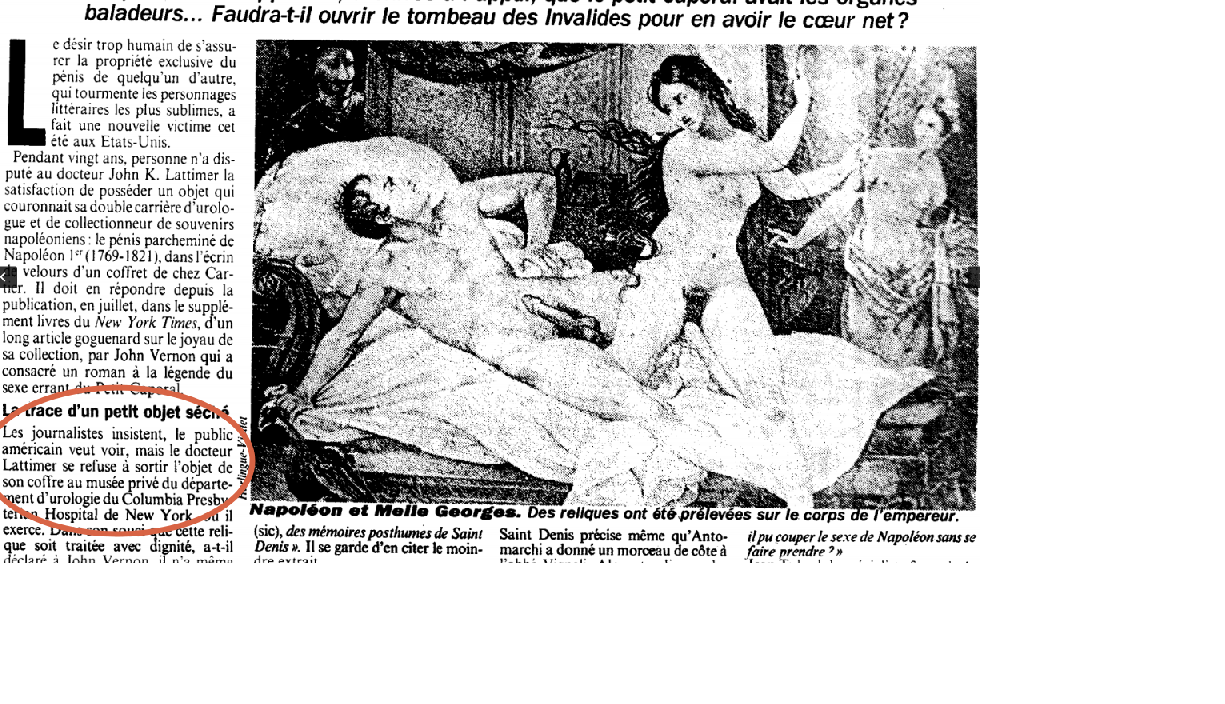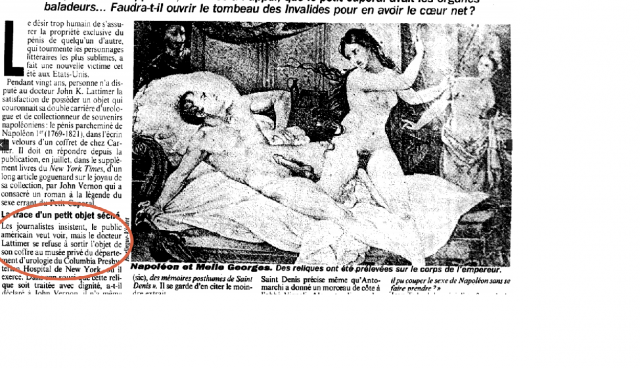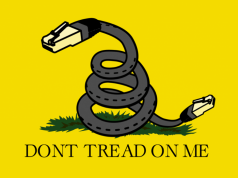A few days ago we dug up a great piece about Napoleon’s 3rd little finger, or something like that. But nothing is neither small nor simple when it comes to Napoleon.
First, William Colby, L’47 reacted in disbelief:
3028 DENT PLACE. N.W. WASHINGTON. D.C. 20007 202-338-5231 November 29, 1991 The Editor Columbia 3 Claremont Avenue New York NY 10027 Sir/Madam: Let me express my outrage at the story in your Fall 1991 edition on the subject of Napoleon's penis. The article is atrocious enough, but the real obscenity is the fact that Columbia University has harbored this relic over the years. I neither view the Emperor as a hero of the French nor as the scourge of Europe, but this kind of concentration on a private part of his being I do view as unseemly. Could the University not over the years of my grandfather's, my father's, my and my son's loyal relationship with it not have quietly returned this personal memento to the French Government to have reinterred it in whatever fashion it might have decided? Or could it now do so, without the attention of your prurient reporters? cc: President Michael Sovern

But who is Mr. Colby? Apparently a Columbia Law School graduate (L47) and more. A year later, in 1992, a NY Times letter-writer divulges his pedigree: a former CIA director, with enough time on his hands during retirement to be outraged by dangling imperial parts:

…And if this is not enough of a sequel, the French got interested in the American-held French hostage, because like everybody else, they wanted to see what happens to magnificence after death. Nothing. And that is hard to see. Or maybe comprehend:
Then, in 1994, a few years after Jessica Raimi started it all, Dr. Lattimer put on a second appearance, this time not for Columbia, but for The New York Times. Here is Michael T. Kaufman’s piece. Well done Dr. Lattimer. TPV wishes you all the privacy you need!
| ABOUT NEW YORK
Michael T. Kaufman
A Collection To Astonish The World We had heard that Dr. John K. Lattimer was quite a collector of unusual things. “So, what’s new?” we asked at the Columbia-Presbyterian Medical Center where the 80-year-old Dr. Lattimer had been chairman of the urology department and where he still tends to his patients.
“Well, the last thing I’ve bought was w. C. Fields’s top hat, but take a look at this.” He took a heavy gold ring from his hand. “This belonged to Hermann G6ring and has his crest.” The doctor reached into a pocket and showed a case made from a cartridge shell in which G6ring, Hitler’s second in command, kept the cyanide he used to commit suicide two hours be fore he was scheduled to hang.
Like many of Dr. Lattimer’s eclectic possessions, this piece had personal significance. “I knew G6ring,” the physician said. After serving as an army doctor at Omaha Beach and in the campaigns that followed he stayed in Europe after the war looking after the Nazi defendants at Nuremberg. “Our job was to make sure they did not kill themselves so we could hang them. With G6ring and two others we failed.”
“l like little things you can carry around,” said Dr.Lattimer. “I found they made me an appreciated dinner guest.” But the doctor made it clear that the things he has in his house and in storage were hardly limited to portable items. “I guess I have more than a thousand things.” he said, adding that he had never sold anything he had acquired. “l have swords that are on display at the Metropolitan. I have George Washington’s sword. I have 10 cases of materials |
THE NEW YORK TIMES METRO
Saturday, July 9, 1994
pertaining to Lincoln’s assassination. I have dinosaur footprints, the skull of a saber-toothed tiger, bones of the woolly mammoth, J. Robert Oppenheimer’s porkpie hat, lots of things.”
Dr. Lattimer said that when he was a boy going to public school in Queens he was given a French needle bayonet that a friend of his father had brought back from World War I. He also had a sword that belonged to Ethan Allen, an ancestor of his. Through the years at Columbia, studying and then teaching, his collection grew. “I have four degrees signed by Nicholas Muray Butler,” said Dr. Lattimer, referring to the late president of the university who became his patient. “I also have his prostate in a bottle.”
While at Columbia, where he set the A.A.U. 220-meter hurdle record, he was offered and bought the knife that was used to attack Secretary of State William Henry Seward in his bed on the same night that President Lincoln was shot. That led to the col lection of Lincoln materials. “Look here,” said the physician, pulling another item from his pockets. It was a case containing the key to box number 7 at Ford’s Theater, where Lincoln was shot.
After the war, Dr. Lattimer ran a government project that stamped out kidney tuberculosis through the use of new drugs. He developed the field of pediatric urology and at the age of 35 became the chairman of the urology department, holding that post for 30 years. After the assassination of President Kennedy, he was the first nongovernment Investigator to be permitted to study the autopsy materials and he wrote a book, “Kennedy and Lincoln, Medical and Ballis tic Comparisons of Their Assassinations.” He also wrote a book about the history of the town where he lives, calling it “This Was Early Englewood, From the Big Bang to the George Washington Bridge.” |
Meanwhile, he explained, he kept buying things.
This seemed the right place to bring up the acquisition that had brought Dr. Lattimer his greatest notoriety as a collector.
“Yes,” he said, “I do own Napoleon’s penis.”
He explained that he had been contacted by a Parisian family who were the descendants of Ange Paul Vignali, a priest and doctor who had attended Napoleon on St. Helena and who conducted the au .topsy when the Emperor died in 1821. ·In exile, Napoleon had scorned Vignali, a fellow Corsican, and Dr. Lattimer assumes the physician took his revenge. “About 20 years ago, I bought several things from the family, including the urological relic,” he said. Dr. Lattimer said his acquisition drew little attention until two years ago when a letter was published in The New York Times Book Review, responding to the review of a novel about the search for Napoleon’s phallus. The letter noted that fact was at least as strange as fiction and that the item was in “a prominent New Jersey collection and is now owned by a surgeon at the Columbia-Presbyterian Medical Center.”
Dr. Lattimer said that as a result he had been visited by television crews from all over the world.”They all want to film it but I have re fused,” he said.”After all, there is such a thing as privacy.”
|













